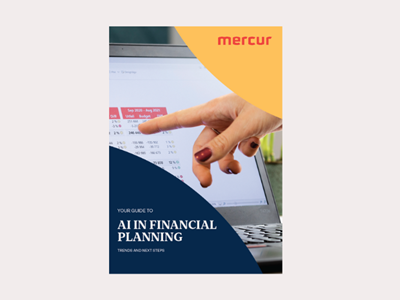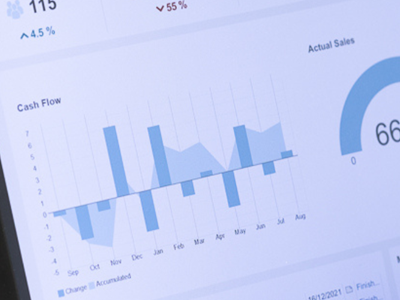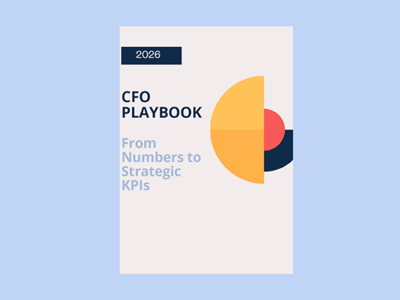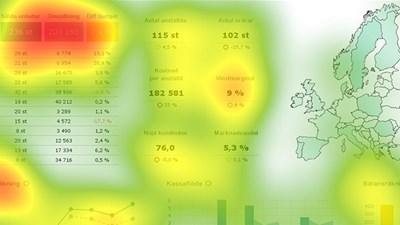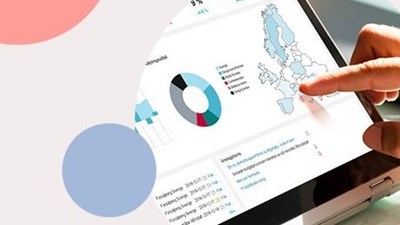.jpg?TS=638931715081752479)
Top PowerBI Alternatives in 2025: Why Teams Choose Mercur
PowerBI turns raw data into visually rich reports you can act on. Its robust analysis and reporting features make it a safe choice for data analysts, business strategists, and operations teams who need to make fast, data-backed decisions.
However, PowerBI also has some feature limitations and a restrictive pricing model that makes users turn to top solutions like Mercur. Below, we dive into the best alternatives to PowerBI to help you make the right decision for your business.
Why Users Seek Alternatives to PowerBI
Power BI is a widely used business intelligence tool from Microsoft. It offers powerful data visualisation, reporting, and analysis features, with deep ties to the Microsoft ecosystem.
At first glance, it is a complete solution for businesses of any size.
But here’s the catch: Power BI’s true power comes with complexity and cost.
It works well for individuals or small teams using the Pro license at €14/user/month. But as soon as your organisation needs to:
Share dashboards widely
Handle large data models
Build real-time dashboards
Use advanced AI or paginated reports
To access more advanced features, organisations are often moved into premium pricing tiers, with monthly costs reaching into the thousands.
And even then, you’ll face:
A steep learning curve, especially with DAX and data modelling
Performance issues on large or complex datasets
Limited collaboration features (no real-time multi-user editing)
A licensing model that often feels like a moving target for growing teams
Why Many Teams Choose Mercur as a PowerBI Alternative
Many growing organisations find that Mercur Business Control delivers the advanced planning and analysis they need, without the hidden costs or technical complexity that come with scaling PowerBI. Here’s how Mercur delivers a more efficient and scalable alternative:
All-in-One CPM and BI Platform
Mercur combines corporate performance management and business intelligence in a single application, eliminating the need to stitch together multiple tools. Your finance, operations and project teams work from one single source of information, ensuring data accuracy.
Predictable, Capacity-Based Pricing
With Mercur, you don’t have to shell out thousands monthly to get access to “premium” features. Instead, you pay for dedicated capacity rather than per-user licences. That flat-rate model removes the guesswork and simplifies your budgeting process.
KPI and Target Management
Mercur gives you an overview of how you’re tracking against your strategic targets, with real-time visibility into trends and variances. Everything is presented visually through Gantt charts alongside dashboards, scorecards and reports to give a clear, step-by-step view of your progress.
ERP Integration
You can integrate Mercur with your favourite software, including IFS, Oracle and Unit4 and collaborate across departments with ease. This way, all your data is in one place, and you can make data decisions from multiple sources that matter to you.
How Mercur Compares to Other PowerBI Alternatives
Before we dive into the featureset of each tool, here’s a quick overview of all PowerBI alternatives and their functionalities:
Platform | Selling Points | ERP Integration | CPM Capabilities |
Mercur | Unified CPM and BI, predictable pricing, deep ERP integrations | IFS, Oracle, Unit4 & more | Yes (built-in) |
Tableau | Extensive custom charts and community templates | Yes | No (requires external FP&A tools) |
Anaplan | Connected planning, strong collaboration across departments | Limited direct ERP connectors | Yes |
Vena | Excel-native interface with CPM features | Integrates with Microsoft stack | Yes |
Jedox | Integrated CPM and BI, strong budgeting and forecasting | Yes (SAP, Microsoft, Oracle) | Yes |
Pigment | Modern interface, scenario modelling and workforce planning | Limited ERP integrations | Yes |
Unit4 | Purpose-built for service-based organisations, strong ERP integration | Deep native ERP integration | Yes |
IBM Cognos Analytics | Enterprise-grade AI-powered reporting | Yes (requires IBM Planning Analytics) | Limited (needs add-on) |
Planful | Cloud-native CPM, strong FP&A automation | Yes (various connectors) | Yes |
1. Tableau
Tableau is another data visualisation software suitable for teams looking for a powerful analytics tool. Tableau supports extended, customisable FP&A and BI functionality through Tableau Exchange; however, this isn’t an integrated solution, so an additional download is required, unlike Mercur.
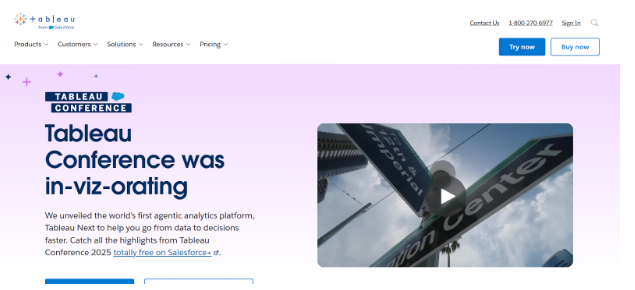
Best for: Visualisation power users who need a rich library of custom charts and community-backed templates
Limitations: Steep learning curve, requires Tableau Prep for data modelling and add-on costs (e.g., Tableau+ for AI) can drive up total spend.
2. Anaplan
Anaplan is a connected planning platform designed for enterprise-level planning across finance, HR, sales, and operations. Its strength lies in creating cross-departmental visibility with collaborative workflows, powered by AI.
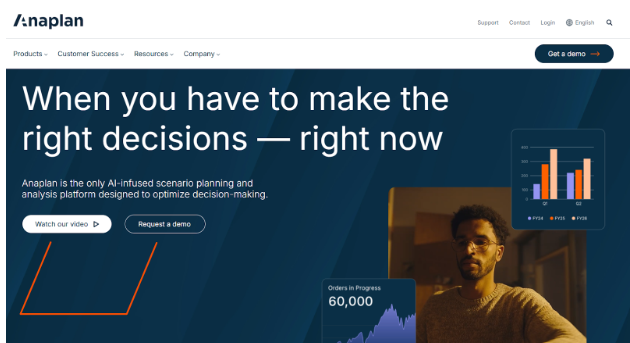
Best for: Large enterprises needing centralised, connected planning across multiple functions.
Limitations: Requires significant implementation effort and expertise; best suited for complex organisations.
3. Vena
Vena combines corporate performance management with the familiarity of Excel. It provides budgeting, forecasting, and reporting with a spreadsheet-style interface but with workflow automation, governance, and integrations.
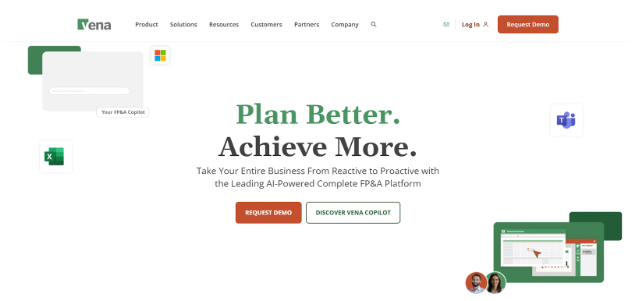
Best for: Finance teams that want a CPM tool while keeping the Excel look and feel.
Limitations: Heavy reliance on Excel interface can feel restrictive for advanced BI needs.
4. Jedox
Jedox is an integrated CPM and BI platform that streamlines processes like planning, budgeting, and forecasting. It supports financial and operational planning with strong reporting and analytics features, while connecting easily to ERP systems.
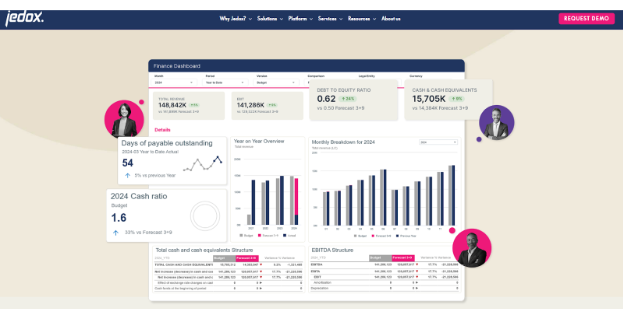
Best for: Organisations seeking an all-in-one planning and reporting tool with flexible integrations.
Limitations: User interface can feel dated; advanced features often require specialised training.
5. Pigment
Pigment is a modern planning platform showing exceptional flexibility in scenario modelling and workforce planning. Its intuitive interface makes it easy for business users to test assumptions and visualise impacts quickly.
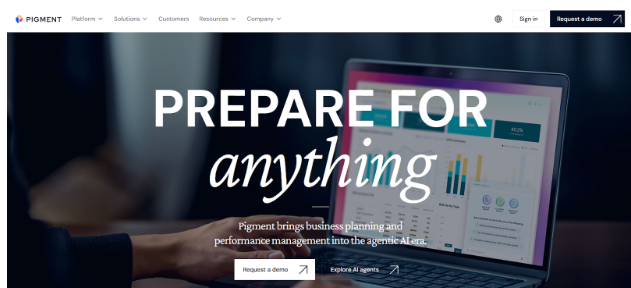
Best for: Fast-growing companies that prioritise agility and scenario modelling.
Limitations: Relatively new platform with fewer pre-built connectors compared to established vendors.
6. Unit4
Unit4 offers CPM capabilities integrated with its ERP solutions, making it a strong choice for service-based organisations such as public sector, higher education, and non-profits.
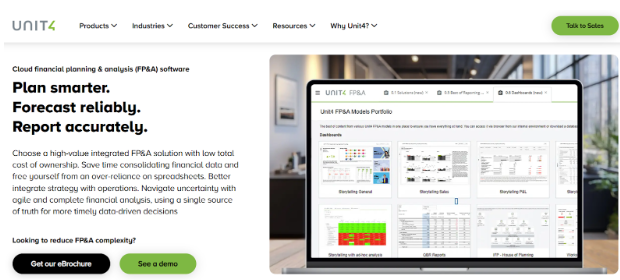
Best for: Organisations already using Unit4 ERP that want a seamless CPM extension.
Limitations: Best value realised when paired with Unit4 ERP ecosystem, limiting flexibility.
7. IBM Cognos Analytics
IBM Cognos Analytics is a business intelligence reporting tool with AI-powered features that significantly ease the workload. It is designed to help organisations make informed decisions by providing insights through dashboards and reports.
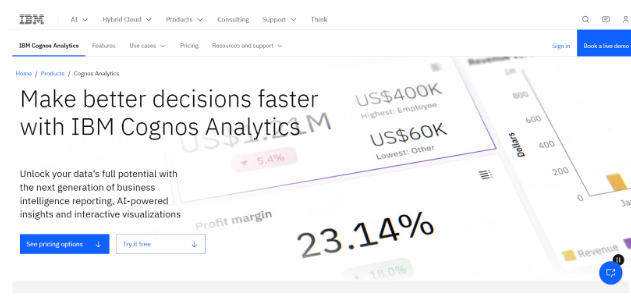
Best for: Organisations that require complex data models and customised queries.
Limitations: Requires integration with IBM Planning Analytics to provide financial planning, budgeting and forecasting.
8. Planful
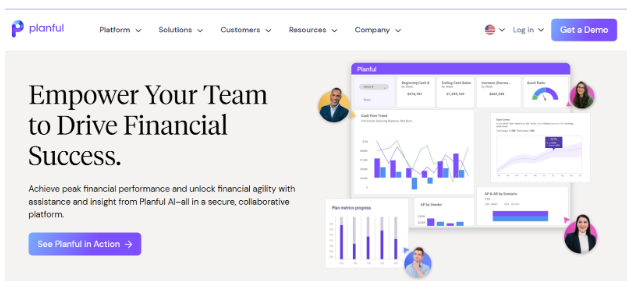
Planful is a cloud-native CPM platform focused on automating FP&A workflows. It streamlines budgeting, consolidation, and reporting while providing strong collaboration features across finance teams.
Best for: Finance teams looking for quick deployment and strong FP&A automation.
Limitations: Reporting features are less advanced compared to dedicated BI tools.
PowerBI Alternatives: Key Takeaways
While PowerBI is a robust analytics platform, many teams outgrow its pricing model and complexity. Mercur stands out as a modern, integrated CPM and BI solution, with built-in planning, optimised pricing and seamless ERP integration, making it a top choice for growing organisations. Also, if you’re not ready to make the switch just yet, Mercur works great alongside Power BI as well!
Ready to simplify planning? Get your Mercur demo now.
 Blog
BlogManagement Reporting Guide: Definition and Tips
Management reporting helps you see what’s really happening in your business. In this guide, we’ll explain what managerial reporting looks like and share practical tips.
 Blog
BlogHow can AI help CFOs make better decisions?
Artificial Intelligence (AI) has significant potential to enhance decision-making for Chief Financial Officers (CFOs) by providing data-driven insights, automating routine tasks, and enabling more accurate forecasts.
 Blog
BlogBalancing Profitability and Sustainability
Sustainability has become a central concern for organisations across the world — and the UK is no exception. This evolving landscape places new demands on financial reporting.
 Blog
BlogWhy is our Excel-based budget always out of date?
Excel creates outdated budgets. Every time someone enters a figure, sends a file, or waits for another department to finish their section, your budget falls further behind reality.
 Blog
BlogMastering Spreadsheets
Where many businesses start small, a simple spreadsheet can adequately perform the limited tasks required of it. As the company grows, your spreadsheets can get more complex and harder to manage, by which point it feels like it will be too difficult to move to a different reporting tool.
 Blog
BlogSpreadsheets Risk the Future of the Business
Spreadsheets often start as just a list for storing information and there is minimal process documentation, support or maintenance for these worksheets. Despite the fact that desktop applications such as Microsoft Office are included in the standard configuration of users' PCs, very little formal training is ever given to spreadsheet users.
 Blog
BlogSave time and create a successful budget process
If you’re working in a large organization, you’re probably aware of how time-consuming the budget process can be. In this article we’ll give you tips on how to save time and still create a successful budget process
 Blog
BlogWhat Is Planning, Budgeting and Forecasting?
Planning, budgeting and forecasting are rarely static. Shifts in the industry often require you to revisit assumptions, adjust targets and adopt new processes. Learn how to strengthen your approach and stay ahead of change.
 Blog
BlogSpreadsheet Risk Management: Best Practices for 2025
Excel has long been a target for hackers; just one click on a malicious attachment can infect your entire network. So, how can you keep using spreadsheets while not sacrificing your safety?
 Blog
BlogWhat is Corporate Performance Management? (CPM)
CPM, or Corporate Performance Management, is a process within corporate management aimed at measuring and optimizing the performance of an organization. CPM encompasses a range of activities, including budgeting, planning, forecasting, reporting, and analysis.
 Blog
BlogWhat Is FP&A? Definition, Purpose, and Best Practices
Without solid financial planning and analysis (FP&A), businesses operate in the dark. In this post we go deeper into the process of FP&A and why it’s important for businesses.
 Blog
BlogInformed Business Decisions at Maximum Velocity
The ability to process information swiftly is essential. If your business can’t manage your data efficiently, your company’s financial performance will surely underperform. At Mercur we have developed our own database Veloxic which helps Financial Planning and Analysis.
 Blog
BlogAI and Machine Learning, what is it, and why is it important for the future?
Artificial Intelligence and Machine Learning, what is it, and what is the difference?
 Blog
BlogThe Hidden Cost of Data Silos
If you ever feel like your teams speak different languages when it comes to data, it is a classic symptom of data silos. The information gets stuck in one department, system or tool, making it difficult for anyone to see the full picture.
 Blog
BlogA practcial guide to scenario planning
Scenario planning gives you a clear, practical way to test assumptions, spot risks and opportunities, and make better strategic choices so your organisation stays resilient when conditions change.
 Blog
BlogAI in Finance as a Powerful Tool
In this post, we explore how AI is evolving from a theoretical concept into a valuable resource for decision-making. Get useful insights for finance teams at any stage, from early exploration to actively using AI-powered solutions.
 Blog
BlogBuild Long-Range Planning for Business Success
Discover how effective long-range planning aligns strategy, finance and operations for smarter decisions and sustainable growth.
 Blog
BlogCash Flow Forecasting
Inaccurate cash flow forecasting can be a costly mistake for companies. In today’s volatile market, relying on static annual budgets or manual spreadsheets leaves financial leaders without the agility to respond to uncertainty.
 Blog
BlogFive tips for a successful budget process!
How can you make your budget process more successful and maximise the effort that was invested in creating it? Of course, there are many factors to consider but we’ve chosen to highlight five key areas that will enable and help you create a smoother, value-creating and collaborative budget process.
 Blog
BlogRolling Forecasts: Practical Steps, Benefits, and How to Get Started
Financial planning has changed. Traditional annual budgets can’t keep up with rapid shifts in the market, evolving customer needs, and internal performance dynamics. That’s why many finance teams are turning to a rolling forecast model.
 Blog
BlogAI in Financial Planning: Trends and Next Steps
Discover how finance teams are using AI to drive smarter planning, faster insights, and stronger business decisions.
 Blog
BlogThe Role of the CFO: Top Priorities and Responsibilities
Today's finance leaders steer more than just budgets and reports. The digital transformation ramps up with the increase of corporate complexity, and so does the role of CFOs.
 Blog
BlogTop 7 Manager KPIs for Financial and Operational Success
In today's post we'll break down why KPIs matter, which ones offer the most insight for finance and executive teams and how to ensure they're actually driving results.
 Blog
BlogAI in corporate budgeting
Artificial Intelligence (AI) can support decision making in key areas such as budgeting, capital allocation and even corporate strategy and as a result, it is increasingly being deployed in corporate performance management tools (CPM).
 Blog
BlogHow to Effectively Budget with Driver-Based Forecasting
Traditional models of forecasting rely on historical data and beliefs. It uses techniques that identify patterns, which are simple to use. However, with these methods, there are some challenges because they are not dynamic with today’s market, and can’t effectively analyse complex data.
 Blog
BlogSpreadsheets are not Collaborative Tools
Spreadsheets were never designed for collaboration, yet they are the single most used program among teams and co-workers. They often start out as a quick document for storing, formatting or calculating information but evolve into important documents and are often the core records for an organisation.
 Blog
BlogBusiness Budgeting Software: How to Choose the Right One
Choosing budgeting software is partly a finance and partly a strategic decision. The right tool helps organisations organise planning cycles, adapt as the market changes and increase accountability across departments. But not every platform will be a good fit.
 Blog
BlogBetter Revenue Planning
Sales forecasting is the process of predicting future revenue based on past data and trends. Read the blog to learn the best methods to do it right.
 Blog
Blog3‑Statement Model for Better Financial Forecasting
Financial forecasting is critical for any business that wants to adapt to change. But finance teams keep usingfragmented models and manual processes. The 3-statement financial model is the solution.
 Blog
BlogBest Guide to Improve Your Revenue with Flexible Budgeting
Optimise your expenses with flexible budgeting, and learn how to adjust budget to reflect current business activities, market changes and cost fluctuations.
 Blog
BlogBusiness Intelligence Reporting For Finance Teams
The real challenge today isn’t collecting data, it’s making sense of it and fast. Organisations turn to business intelligence (BI) to convert raw data into insight.But how do you actually do it right?
 Blog
BlogScenario Planning - Better control during uncertain times
Uncertain times create the need for more frequent forecasts and time for analyzing and comparing different future scenarios. We give you 5 tips on how to simulate future scenarios using scenario planning
 Blog
BlogWhat is management reporting?
Management Reporting refers to the process of creating, analyzing, and presenting information about various aspects of an organization's performance to enable decision-makers to make well-informed decisions about the future.
 Blog
BlogRisks with working in spreadsheets
Spreadsheets are an essential tool for all types of organisations and businesses rely on them heavily, particularly for financial computations. The most popular spreadsheet program globally is, of course, Microsoft Excel, it’s used by an estimated 750 million people.
 Blog
BlogCFO Playbook - KPIs for 2026
The role of the CFO is changing fast. Today, the finance function is expected to deliver more than reports — it must drive direction, speed and profitability through clear, actionable KPIs. Learn more in this guide.
 Blog
BlogTop-Down vs Bottom-Up Budgeting
Budgeting aligns resources with strategic goals, and there are two primary approaches: top-down and bottom-up. Which method wroks best?
 Blog
BlogZero-Based vs. Incremental Budgeting
Budgeting sits at the heart of sound financial management. This is why choosing the right technique is crucial for CFOs – it shapes resource allocation, cost control and strategic agility. Incremental and zero-based budgeting are two leading methods that offer distinct approaches.
 Blog
BlogFrom static budgets to agile financial management
Traditional budgeting has long been the cornerstone of financial planning in businesses. But today it can become more of a limitation than a strength. That’s where the concept of Beyond Budgeting comes in.
 Blog
BlogWhy xP&A is a powerful game-changer
The newest iteration of planning, analysis and reporting systems is a powerful game-changer that unites company departments and boosts competitiveness. It’s called xP&A – the abbreviation of extended financial planning and analysis.
 Blog
BlogHow to succeed with your planning, budgeting, and forecasting process
We know it can be challenging to succeed with your planning, budgeting, and forecasting process. Therefore, we have gathered our best tips for you to succeed!
 Blog
BlogBoost Report Readability, Engagement, and Decision-Making
In today’s fast-paced business environment, effective reports and dashboards are crucial for decision-making. Our user study using eye-tracking technology revealed seven key insights into what captures attention.
 Blog
BlogHow To Create a Successful Budgeting Process
When done well, budgeting helps organisations stay financially on course, even when things don’t go exactly as planned. Learn how to keep things on track so you avoid surprises and stay focused on your goals.
 Blog
BlogVariance Analysis: A Comprehensive Guide
Senior executives are demanding more detail in their management reports. The amount of data available to finance departments has exploded and decision makers see this as an opportunity to get more insight into how the business is performing.
 Blog
BlogThe Collaborative, Smarter Budget
In many organisations manual budgeting processes over-burden staff and create masses of data which overwhelms department heads and stops them seeing the bigger picture.
 Blog
BlogThe Business Benefits of Integrated Business Planning
This blog explores what IBP is and the typical IBP process. We highlight business benefits and how the right software can be a game-changer for your organisation.
 Blog
BlogThe Powerhouse of EPM Tools
A business’s success heavily relies on having a strong strategy. However, what's even more important is implementing that strategy while tracking and measuring the performance. This can easily be done by investing in enterprise performance management (EPM) software.
 Blog
BlogFP&A Trends Shaping Financial Planning in 2025
Many organisations cope with fragmented planning and data quality issues, which slow down their forecasting cycles. This forces organisations to take practical steps to turn ambition into execution.
 Blog
BlogHow Automated Reporting Will Transform FP&A in 2026
This article highlights the power of report automation, how to implement it in your business and explores any new opportunities for accurate financial analysis in the long run.
 Blog
BlogBudgeting in a modern world
Thirty years after its debut, Microsoft Excel is still the preferred tool for budgeting and planning projects. However, its popularity is declining, due in most part to the rise of technology and subscription-based pricing for a myriad of SaaS-based products.
 Blog
BlogHow do finance teams track KPIs across the entire organisation?
Learn how finance teams track KPIs across the entire organisation by consolidating data from multiple sources into a unified system like Mercur.
 Blog
BlogHow to get accurate financial reports without waiting for month-end
You don't need to wait until month-end to see accurate financial reports. With modern financial systems you can access up-to-date reports whenever you need them.
 Blog
BlogHow EPM Transforms Financial Planning and Forecasting
Struggling to keep plans aligned in a changing market? Discover how EPM helps finance teams move faster, stay accurate and lead with real-time insights.





















